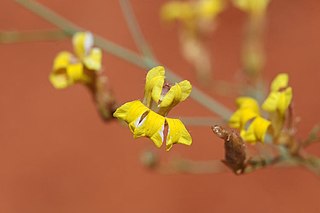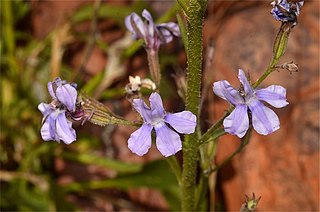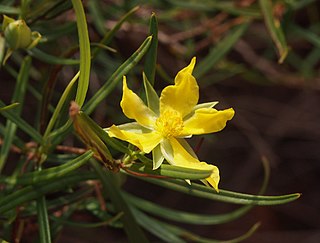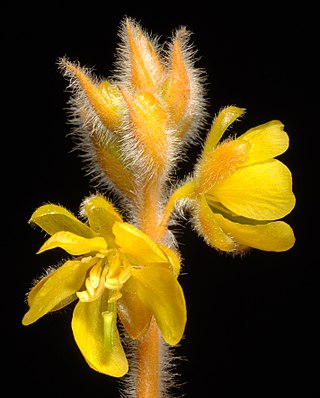
Hypocalymma xanthopetalum, commonly known as yellow myrtle, is a species of flowering plant in the myrtle family Myrtaceae, and is endemic to the south-west of Western Australia. It is a low-growing to erect or sprawling shrub with sessile, oblong leaves, and pale to bright yellow flowers with 80 to 135 stamens.
Balaustion grande is a species of flowering plant in the family Myrtaceae and is endemic to the south-west of Western Australia. It is a low-growing shrub with oblong or narrowly oblong leaves and usually white or pale pink flowers with 16 to 28 stamens fused in a ring.

Quoya loxocarpa is a flowering plant in the mint family Lamiaceae and is endemic to Western Australia and the Northern Territory. It is an open shrub with many spindly tangled branches. The leaves are oblong and woolly when young and the flowers are whitish pink with purple spots inside and are surrounded by woolly sepals.
Calytrix purpurea is a species of flowering plant in the myrtle family Myrtaceae and is endemic to the south-west of Western Australia. It is a spreading shrub with linear leaves and purple flowers with a yellow base, and about 45 to 55 yellow stamens in four rows.

Micromyrtus flaviflora is a species of flowering plant in the myrtle family, Myrtaceae and is endemic to inland areas of Australia. It is an erect shrub with overlapping, keeled, oblong leaves, and yellow flowers arranged singly in leaf axils, but often appearing clustered.
Micromyrtus stenocalyx is a species of flowering plant in the family Myrtaceae and is endemic to the inland of Western Australia. It is a straggly or widely spreading shrub with oblong or club-shaped leaves pressed against the stem, and cream-coloured to yellow flowers with 10 stamens.

Dicrastylis beveridgei is a species of plant within the genus, Dicrastylis, in the family Lamiaceae. It is found in Western Australia, the Northern Territory, and South Australia.

Dicrastylis lewellinii is a species of plant within the genus, Dicrastylis, in the family Lamiaceae. It is found in Western Australia, the Northern Territory, New South Wales, Queensland and South Australia.

Goodenia azurea, commonly known as blue goodenia, is a species of flowering plant in the family Goodeniaceae and is endemic to northern Australia. It is an erect, dense, spreading or sprawling, glaucous, perennial herb with egg-shaped leaves with the narrower end towards the base, racemes or thyrses of bluish-purple flowers with leaf-like bracts, and oval to cylindrical fruit.

Commersonia craurophylla, commonly known as brittle leaved rulingia, is a species of flowering plant in the family Malvaceae and endemic to southern continental Australia. It is a dense, spreading shrub with crinkled, narrowly oblong to linear leaves, and white to cream-coloured flowers.

Goodenia lamprosperma is a species of flowering plant in the family Goodeniaceae and is endemic to northern Australia. It is an annual or perennial herb with linear to lance-shaped leaves sometimes with teeth on the edges, and racemes of yellow flowers.

Goodenia ramelii is a species of flowering plant in the family Goodeniaceae and is endemic to central Australia. It is a perennial herb with toothed, elliptic leaves in a rosette at the base of the plant, and racemes of blue flowers.

Hibbertia glaberrima is a species of flowering plant in the family Dilleniaceae and is endemic to Central Australia. It is a glabrous, spreading shrub with oblong to lance-shaped leaves and yellow flowers borne singly in upper leaf axils, with 30 to 150 stamens arranged around three carpels.

Senna notabilis, commonly known as cockroach bush, is a species of flowering plant in the legume family Fabaceae, and is endemic to northern Australia. It is an erect, softly-hairy, annual or perennial shrub with pinnate leaves with six to twelve pairs of lance-shaped leaflets, and yellow flowers arranged in groups of twenty to thirty, with seven fertile stamens in each flower.

Commersonia magniflora is a species of flowering plant in the family Malvaceae and endemic to Australia. It is an erect shrub with wrinkled, narrowly oblong to elliptic or egg-shaped leaves, and deep pink flowers.
Senna heptanthera is a species of flowering plant in the family Fabaceae and is endemic to Arnhem Land in the north of the Northern Territory. It is a creeping, herbaceous perennial with pinnate leaves with one or two pairs of broadly egg-shaped leaflets, and yellow flowers arranged in groups of eight to ten, with seven fertile stamens in each flower.

Senna magnifolia is a species of flowering plant in the family Fabaceae and is endemic to northern Australia. It is an erect, spreading or straggling, mostly glabrous shrub with pinnate leaves with four to six pairs of broadly oblong to round leaflets, and yellow flowers arranged in groups of twenty to sixty, with seven fertile stamens in each flower.

Senna oligoclada is a species of flowering plant in the family Fabaceae and is endemic to northern Australia. It is an erect shrub with pinnate leaves with one to three pairs of elliptic to egg-shaped leaflets, and yellow flowers arranged in groups of three to five with ten fertile stamens in each flower.
Calytrix megaphylla is a species of flowering plant in the myrtle family Myrtaceae and is endemic to the Northern Territory. It is a shrub with linear to narrowly elliptic leaves and pink to pinkish mauve or reddish purple flowers with a paler base, and with about 20 to 50 pink stamens in several rows.

Ptilotus aervoides, commonly known as mat mulla mulla, is a species of flowering plant in the family Amaranthaceae and is endemic to western Australia. It is a prostrate, mat-forming annual or short-lived perennial herb, its stems densely hairy at first, egg-shaped to spatula-shaped stem leaves, dense spikes of hairy creamy-green flowers with two or three fertile stamens.
















